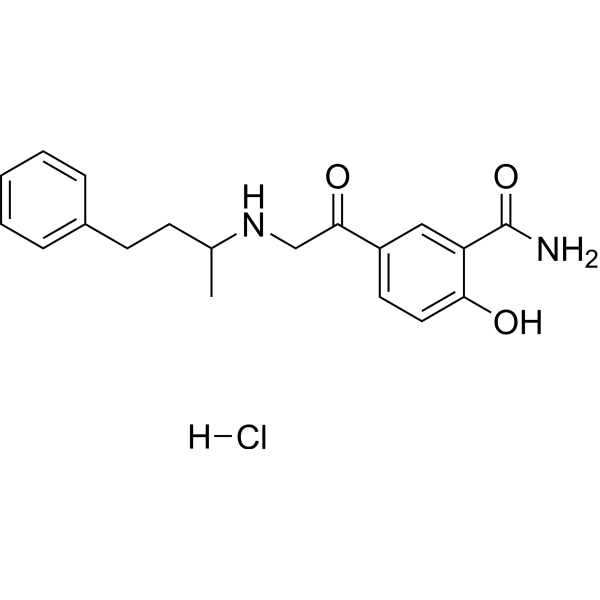
Labetalone hydrochloride
CAS No. 96441-14-4
Labetalone hydrochloride( Benzoic amide )
Catalog No. M28024 CAS No. 96441-14-4
Labetalone hydrochloride is an impurity of Labetalol. Labetalol is an orally active adrenoceptor blocking drug, Labetalol is a competitive antagonist at both alpha- and beta-adrenoceptor sites.
Purity : >98% (HPLC)
 COA
COA
 Datasheet
Datasheet
 HNMR
HNMR
 HPLC
HPLC
 MSDS
MSDS
 Handing Instructions
Handing Instructions
| Size | Price / USD | Stock | Quantity |
| 10MG | 35 | Get Quote |


|
| 25MG | 58 | Get Quote |


|
| 50MG | 88 | Get Quote |


|
| 100MG | 155 | Get Quote |


|
| 200MG | 230 | Get Quote |


|
| 500MG | 390 | Get Quote |


|
| 1G | Get Quote | Get Quote |


|
Biological Information
-
Product NameLabetalone hydrochloride
-
NoteResearch use only, not for human use.
-
Brief DescriptionLabetalone hydrochloride is an impurity of Labetalol. Labetalol is an orally active adrenoceptor blocking drug, Labetalol is a competitive antagonist at both alpha- and beta-adrenoceptor sites.
-
DescriptionLabetalone hydrochloride is an impurity of Labetalol. Labetalol is an orally active adrenoceptor blocking drug, Labetalol is a competitive antagonist at both alpha- and beta-adrenoceptor sites.
-
In Vitro——
-
In Vivo——
-
SynonymsBenzoic amide
-
PathwayOthers
-
TargetOther Targets
-
RecptorEPAC2|EPAC1
-
Research Area——
-
Indication——
Chemical Information
-
CAS Number96441-14-4
-
Formula Weight362.85
-
Molecular FormulaC19H23ClN2O3
-
Purity>98% (HPLC)
-
SolubilityIn Vitro:?DMSO : 100 mg/mL (275.60 mM)
-
SMILESCl.CC(CCc1ccccc1)NCC(=O)c1ccc(O)c(c1)C(N)=O
-
Chemical Name——
Shipping & Storage Information
-
Storage(-20℃)
-
ShippingWith Ice Pack
-
Stability≥ 2 years
Reference
1.Chen H, et al. 5-Cyano-6-oxo-1,6-dihydro-pyrimidines as potent antagonists targeting exchange proteins directly activated by cAMP. Bioorg Med Chem Lett. 2012 Jun 15;22(12):4038-43.
molnova catalog



related products
-
Caloxin 2A1
Caloxin 2A1 is an extracellular plasma membrane Ca2+-ATPase (PMCA) peptide inhibitor. Caloxin 2A1 does not affect basal Mg2+-ATPase or Na+-K+-ATPase.
-
Butralin
Butralin is a herbicide and a plant-growth-controller.
-
YM-750
YM-750 is a potent acyl-CoA:cholesterol acyltransferase (ACAT) inhibitor (IC50=0.18 μM). ACAT catalyzes the formation of cholesteryl esters from cholesterol and long-chain fatty-acyl-coenzyme A.



 Cart
Cart
 sales@molnova.com
sales@molnova.com


